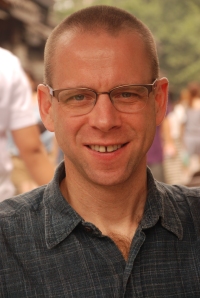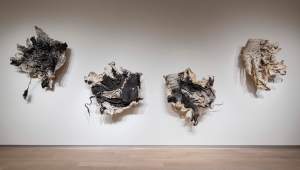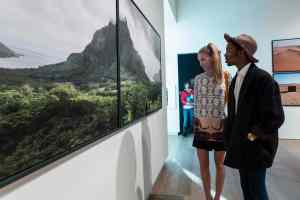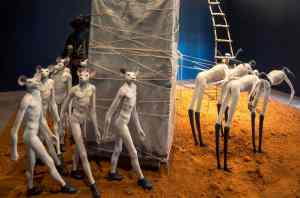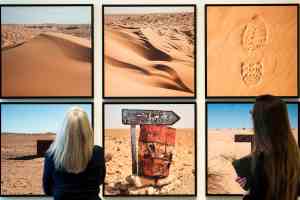The fight against ebola Interview with Dr. Roberto Ravera, PhD, Chief of Staff at ASL 1 Imperiese Psychology, President of FHM Italy Onlus (www.fhmitalia.org ), Director of Ravera Children Rehabilitation Centre – RCRC – Freetown (Sierra Leone)
What led to your personal battle against Ebola? I have been personally promoting projects with socio-medical cooperation in Sierra Leone for more than ten years and I realise now, more and more clearly, that their normal daily lifestyle is what we define as emergency measures. Whether it’s a long civil war with corruption and greed, floods, cholera or Ebola. Sometimes it’s as if I were wading a river: I have now arrived on the other side, however I notice that there is a new, difficult passage and the current becomes impetuous. Then I think that if it appears difficult to me, think about all those poor people who have miserable incomes, to those many children splitting stones under the hot sun, to those mothers who have no means to take care of their children, to those street children who seem already old. Despite all the hardships I was seduced by the land and the population won me over with their simple smile. Here I built and forged ties that bind and involve me more every day. That’s why I’m here. Africa has a great charm: modernity and tradition entwine and come together in a product to form a unique Alchemy. The Ebola virus appeared for the first time in Sierra Leone roughly a year and a half ago, after it infected Guinea Conakry and Liberia . The reasons for the spread of the virus are to be found primarily in the fact that, compared to previous Ebola outbreaks in other parts of Central Africa, the virus encountered modern times. Here too, people are traveling more quickly and there are constant exchanges between villages and towns often without taking necessary precautions so infections spread very easily. Over the years I’ve seen corpses transported like passengers on motorcycles. The virus had begun to spread like wildfire across the country, leaving the local health authorites completely unprepared to deal with the ensuing outbreak. The medical staff was not prepared to deal with an epidemic of this magnitude, it has paid a hefty price considering the high number of Ebola deaths among local doctors and nurses. Only thanks to International intervention has the situation been curbed and contained. Those who, like us, managed health care projects in Sierra Leone were left to face the impact Ebola had on every level. And my Non Governmental Organization Ravera Children Rehabilitation Centre RCRC – which deals with mental health projects for children – had to close the doors of our clinic, which is located in the slum area where the poorest were heavily affected– to minimze the risk of contagion of our healthcare personnel. We worked primarily on prevention: check-point fever measuring stations, discussions and meetings with Tribal leaders and personally providing necessary information to all the people. Then we dealt with the Ebola survivors, all of whom are still traumatized not only for having had the disease and having seen many of their loved ones die but also for having been victims of isolation and stigmatisation. There is still an abbundance of work to be done.
Ebola has been talked about quite extensively, but the perception that the West has is probably pretty vague and imprecise. What, in your opinion, is not related through the media? Ebola is a very dangerous disease like everyone understood. But the real challenge was held on two levels: the first purely and with obvious health aspects of medical anthropology and the second aspect, however, was related to the fact that this virus has affected the collective imagination of the Western world. Wanting to analyze briefly both, we could say that meanwhile what struck the collective imagination was the perception that caregivers work with the fear of the constant danger to become infected as well, with a suit and a face mask and high standards of hygiene, which made everything more expensive and complicated. For a doctor or nurse treating a patient wearing haz mat medical protection combined with the heat of the tropics, under sterile tents, was mind boggling combined with the relevant fatigue and fear of making mistakes with the new and overwhelming security procedures. Many new health structures and hospitals were built with great care by the Western countriesand are equipped with expensive equipment never seen in these places, which unfortunately will be dismantled at the end of the epidemic. The international media went to town showing this nightmarish situation. Yet, despite the effects of the disease were perfectly visible to the local population, the biggest difficulty was to make people understand that it was necessary to adhere to specific behaviors in terms of hygiene and treatment of Ebola deaths in funeral rituals. All things in the West may seem obvious but here, where magic is an essential part of everyday life, is not so obvious that you should clean the sphincters of those who died of Ebola. There have been cases of people buried by the health authorities and, at night, unearthed by the family to carry out the purification rituals. Or clashes with the police or with the medical staff entering the villages where they knew there was one fatality due to the virus. For those who know this world one understands very well that you cannot ignore all of these customs. Many Ebola patients turned to shamans and healers running risk of infecting other people and delaying the start of medical care. A local anthropologist confided in me the particularity of Ebola is being undermined in the world of relationships: it is absolutely natural for these people to care for and embrace a child or a sick friend much weakened by the disease and not able tostand more upright. For this you can call the virus of love, ties and relations, because that’s how it is transmitted. Another problem concerns the image that the Ebola virus had on the Western world and many have seen this explosion of the epidemic, a spectrum or a holocaust from which to take guard. The fact that this horror could cross our borders and our cities, appeared to be something from which they needed to defend and protect themselves from this spectre and curb the diffusion.. When I got back from Sierra Leone a few weeks ago, I was subjected to health checks at the airport of Brussels; but the thing that struck me the most were the instructions on the procedures which had to be submitted, there was the picture of a healthcare professional meaduring the fever with the infrared thermometer. Well, the picture was very eloquent in emotional terms: a far-away doctor pointing a thermometer with an outstretched arm in the direction of the person’s head . Well the feeling was that, rather than being a precautionary medical procedure. it portrayed someone shooting my temple! The fact that thousands of refugees each day enter Europe sparked fear that Ebola was in them. I have the perception that these two worlds, that of the North and the South, are separated by deep mental barriers. At the same time, from theonset of 2015, the interest of what what was happening in West Africa seemed to be waning from all aspects of the media.. When I was in the streets of Freetown in March this year, it was common to see people quarantined in their houses. I visited many quarantine centres run by Non-Governmental Organizations and I always found then full of people sadly waiting for a verdict. The international press moved on and found something else more relevant to focus on when the pain became routine. The first fase of morbid astonishment was over: the look inside the abyss and thinking that alien species-Ebola-arrived and entered our House. I would just like to n mention that in Sierra Leone time stood still for a whole year: schools, universities, many hospitals and health centres were closed. Just a few weeks ago in April students went back to school. This infinity of time blocked the social and economic life of a country as a whole.
How do you operate in an environment so culturally different from ours? The basis of my work in Sierra Leone focuses on mental health in children. You can’t ignore a profound vision of cultural and anthropological differences and for that very reason many psychological issues in Africa have different manifestations compared to us. I have to say that most of the efforts made in recent years, since working with child soldiers after the war,was the search for a balance between ‘ cure ‘ and adaptation to the principle of ‘ operation ‘ in the context of local life. It is useless to pursue Utopian models of rehabilitation, Western type, if however for many of our young people here in Sierra Leone, returning to a normal life implies simply having something to eat, a pair of shoes or health care. The great difficulty for those who want to work in a psychological context in Sierra Leone is to learn to ‘ read ‘ the reference culture, without attempting to import Western welfare model. For this I wanted to employ local health care staff from the community and I have sponsored research projects in the field of Neuroscience: to give an objective meaning to what we mean by ‘ ‘ emotional suffering and understand how this interferes in the modeling of social interaction. We have shown how the neurophysiological response of street children or juvenile prison inmates is, to some extent, inadequate in terms of mind reading others. In the article published in Plos One we called this phenomenon “a wall between me and others”, a phenomenon of alteration in social communication that can result in mental disorder. My Non-governmental organisation RCRC believes in the meaning of “early intervention”, i.e. the early intervention, knowing how to recognize psychological disorders as early as possible to facilitate pathways to resilience. The use of violence, the inability to contain the stimuli, the difficulty to express their moods and to build appropriate relationships with others are some of the aspects that characterize the personality disorder. When these mechanisms are established in adults it is difficult to cure. Many of the young people we work with in fact seem unable to experience emotions and only after a period of support and help reveal what they have inside. But here in Sierra Leone, we have to admit with some honesty that even us so-called mental health “experts” it is not easy to get access to this inner world, made of languages and sometimes difficult to understand. When we started developing the project with the Ebola survivors, people toughened by life, nothing transpired in pre-meetings with them. They looked at me without saying a Word. At the end of three days spent together, I saw them recite in the theatre, which we created to represent their ordeal, with such energy and power that would compete with a real actor. Here the theatre, the drama of life, is something every day.
How do you support your Organization’s goals and purposes? My organization, Ravera Children Rehabilitation Centre, has been working for years to create a mental health project for children and to do this we lean on local players. We have trained and worked with them, day after day, selecting the best and the most motivated and giving him opportunities, resources and means to properly operate. We have clinics where we offer free healthcare (while everything here is at an additional cost) present in the poorest slums and can be a point of reference for children which are abused, mistreated, malnourished, sick and orphaned. We took over the juvenile prisons in Freetown, taking care of every kind of assistance and trying to build a future for these young men. We now deal with Ebola survivors and try to support them and help them from a material and psychological standpoint. We have built a therapeutic community to give a basis of hospitality to children with problems and psychological and social distress. We are building a new Pediatric Hospital and a Rehabilitation Centre for minors. My idea has always been to put the baby in the middle and rotate around him the services and centres that can take charge of its problems. This way of working is practically unknown in Sierra Leone. For this our goal is not just to ‘ build ‘ but is to design and give evidence to a new model and paradigm of work. We want to transfer, in a sustainable way, the idea of a draft, a working model, which can be readjusted during the next few years. In order to do all this an Organization was founded in Italy years ago called FHM AUSTRALIA, of which I am Chairman, which aims to fund all projects that we bring forward in Sierra Leone. What we ask people is to grant us trust, to help us to find funds and material to bring in Sierra Leone. Each year, with the help of benefactors, we send containers of food, clothing, and many other things that we distribute to the most needy and thanks to donations we are building a new hospital and reception centre. We are volunteers: what we receive is spent directly on projects. Our website is: http://www.fhmitalia.org
How does the mode of transmission of Ebola change human relations? The mode of transmission of the Ebola virus are known and include contact with any human fluid relative to the person who shows signs of illness. Apparently the virus has a very powerful feature that creeps into the body of whoever is near, relative or caregiver, the sick person infected with it. The problem arose from the fact that the disease causes along with fever, skin rash, vomiting and diarrhoea, a strong state of weakness. This mechanism seems to attract the care givers who can only take charge of the sick person and this causes the infection of entire households. Considering the state of prostration in which hundreds of Ebola survivors stay, we tried a group work experience. We placed over 120 survivors together for three days of interaction and of psychological activity. We heard from their dramatic stories and the testimony of this is featured even in the forms compiled by children : to the question “how many were with you and your family before the onset of Ebola nd how many now?” The reported number is staggering considering that they refer to the concept of atypically African extended family. Basically all the children almost lost the entire family nucleus For this many months ago we argued that the problem would be that of after Ebola. This epidemic has left a deep wound in Sierra Leonean society. Although seemingly everything seems to flow with the typical chaos and frenzy heated harangue of that land, we see the signs of a deep wound in the soul of people and, especially, children. For many months they have been able to touch and be touched, not playing in groups and have lived with the terror of an enemy that you couldn’t see. This is one of the reasons why Ebola is well adapted to the magical thinking that rages in African society. Witches, wizards and demons are considered the real directors of life in general and, specifically, of the events related to Ebola. Some years ago I remember a riduculous video of a demonic wooden statue which was unearthed during the excavation of a local mine that went viral in Sierra Leone and which local people took very seriously. . It was said in these DVDs sold in every corner that House of the devil had been found and everyone in the city spoke of it. Although there were those who laughed, actually it was taken very seriously. For this reason I believe that places like Sierra Leone are representative of an anthropological paradigm where, modernity and its ‘ myths ‘l ives a reality deeply tied to traditions. From this perspective, Ebola has been something that has brought to light contradiction, highlighting that under certain conditions, either too improbable, the balance is moving very fast, and depicts all the fragility of an archaic world that lives under the guise of a modernity.
Africa is at the center of a peculiar process of modernization and there is a widespread perception that within this century, its GDP will have unparalleled growth. Have you noticed this reflected in Sierra Leone? Sierra Leone has had, since the war (2002), a certain development and, in recent years, GDP has grown so large, even with tips of 10%. But we must bear in mind that most of this growth was and is linked to the export of raw materials that it is rich (gold, diamonds, iron, rutile, and maybe even fish oil). Monographic issue of December 2014 The Africa Report magazine draws future scenarios for many African countries and it shows that in many areas there is innovation and development, but everything is still very attached to the influences of the large multinationals and economic policies of dominant Western countries. Regarding Sierra Leone you can tell if you look at the impressive dimensions of the US Embassy in the hills of Freetown, capital of Sierra Leone. The same thing concerns the Chinese influence, taking into account, for example, hospitals and roads that the Chinese have built in exchange for various orders. One of these, just north of Freetown, is the large investment of a great iron mine in the Boonbuna area acquired for 100 years. They built out of nowhere the only country railway, used only for transportation of ferrous material that is transported up to the Pepel and from there transferred to huge ships to China. What remains of that beautiful territory, made of beautiful rainforests, after decade only 42% of the population have the basic level of education and inflation is at 9% (end-2014 data in Ebola). Yet the penetration of new telecommunications is consistent and 44% of the population have a mobile phone and foreign investment amounted to 579 million dollars. Freetwon has become a city without borders with two million inhabitants; but inside there is nothing of the old protective culture of the village, the streets are full of street children who no longer have the protection of the village, but stragglers wandering looking for a way to make ends meet. Children that we see in juvenile prisons, are abbandoned and worse a small boy was sentenced to 16 years in prison just because he found a submachine gun in the jungle and fired some shots in the air. I think the key to a better future must necessarily start from below: building a cooperative of workers, even with the support of many Non-governmental Organizations active in Sierra Leone, and being able to expand in the poorest and underdeveloped areas. Above all, a model of Welfare should be implemented because still today there is a charge for everything and also go to school involves a costly expenditure for families already destitute. Unfortunately the percentage of the population that is alien to any development is still considerable. Along the Freetown peninsula, on the way Kent, you see many children along the road commiing from quite some time: trying to protect children and support their education and care, only through this process can be a hope and a better life
In Italian
Intervista a Roberto Ravera, Primario SC Psicologia ASL 1 Imperiese, Presidente di FHM Italia Onlus (www.fhmitalia.org ), Direttore di Ravera Children Rehabilitation Centre – RCRC – Freetown (Sierra Leone)
Cosa l’ha spinta ad iniziare la sua personale battaglia contro l’Ebola? Sono quasi dieci anni che porto avanti progetti di cooperazione socio-sanitari in Sierra Leone e mi rendo conto, sempre più chiaramente, che questo è un luogo in cui è ‘normale’ vivere a contatto con ciò che comunemente definiamo un’ emergenza. Sia che si tratti di una lunga guerra civile con corruzione e malaffare, di colera, di alluvioni o di Ebola. A volte è come se dovessi guadare un fiume: ritengo di essere ormai arrivato dall’altra parte, invece mi accorgo che c’è un nuovo passaggio difficile e la corrente si fa impetuosa. Poi penso che se appare difficile a me, figuriamoci a tutte quelle persone che hanno redditi miseri, a quei tanti bambini che spaccano le pietre sotto il sole, alle madri che non hanno mezzi per curare i propri figli, ai ragazzi di strada che sembrano già vecchi. Nonostante tutto il Paese mi ha sedotto, e la popolazione mi ha conquistato anche solo con un sorriso; qui ho costruito legami profondi che mi coinvolgono ogni giorno di più. E’ per questo che sono qui. L’Africa ha un grande fascino: modernità e tradizione si fondono in un prodotto alchemico dal risultato unico. Il virus di Ebola è comparso per la prima vota in Sierra Leone circa un anno e mezzo fa, dopo aver contagiato la Guinea Conakry e la Libera. Le ragioni della diffusione del virus sono da ricercarsi in primo luogo nel fatto che Ebola, rispetto a precedenti epidemie in altre parti del Centro Africa, si è incontrato con la modernità. Anche qui la gente viaggia, si muove velocemente, ci sono continui scambi tra villaggi e città, spesso senza precauzioni, così i contagi si diffondono facilmente. In questi anni ho visto persino cadaveri trasportati, a mo’ di passeggeri, sulle motociclette. Il virus ha cominciato a diffondersi a macchia di leopardo in tutto il Paese, facendo emergere la totale impreparazione da parte delle autorità sanitarie locali. Il personale sanitario non era preparato ad affrontare un’ epidemia di questa portata, infatti ne ha pagato un prezzo salato, considerato l’alto numero di morti per Ebola anche tra medici e infermieri locali. Solo grazie all’intervento internazionale si è riusciti ad arginare la situazione. Coloro che, come noi, gestivano progetti sanitari in Sierra Leone si sono ritrovati a dover affrontare l’impatto che Ebola ha portato in tutti gli ambiti, incluso quello della vita quotidiana. La nostra Organizzazione Non Governativa Ravera Children Rehabilitation Centre RCRC – che si occupa di progetti di salute mentale per minori – ha dovuto chiudere, per un certo periodo, tutti gli ambulatori che avevamo aperto nelle baraccopoli – gli slum più disastrati – per non mettere a rischio il nostro personale sanitario. Abbiamo comunque lavorato molto sulla prevenzione: check-point dove misurare la febbre, riunioni e incontri con i ‘paramount chief’ – i capi villaggi- e informazione continua alle persone. Successivamente ci siamo occupati dei sopravvissuti ad Ebola, i quali sono ancora traumatizzati non solo per aver avuto la malattia e aver visto morire tanti loro cari, ma anche per essersi sentiti vittime dell’isolamento e della stigmatizzazione. Il lavoro da fare è ancora tanto.
Di Ebola si è parlato tanto, ma la percezione che ne ha l’occidentale è probabilmente abbastanza vaga ed imprecisa. Cosa, a suo avviso, non passa attraverso i media?
Ebola è una malattia molto pericolosa come tutti hanno capito. Ma la vera sfida si è giocata su due livelli: il primo meramente sanitario e con evidenti aspetti di antropologia medica e il secondo aspetto, invece, era correlato al fatto che questo virus ha colpito l’immaginazione collettiva del mondo occidentale. Volendo analizzarli brevemente entrambi, potremmo dire che intanto colpiva l’immaginario collettivo il fatto che gli operatori sanitari lavorassero, per il constante pericolo di infettarsi, con una tuta e una maschera protettiva e altissimi standard di igiene e ciò ha reso tutto più costoso e complicato. Per un medico o infermiere curare un paziente con indosso una simile palandrana, con il caldo del tropico, sotto tensostrutture, comportava una fatica davvero considerevole e la paura di errori nelle procedure di sicurezza. Sono stati costruiti, con grande sollecitudine da parte dei Paesi occidentali, diversi ospedali nuovissimi e dotati di costose apparecchiature mai viste in questi luoghi, che purtroppo saranno smantellati al termine dell’epidemia. I media internazionali sono andati a nozze nel mostrare questo contesto da incubo. Eppure, nonostante gli effetti della malattia fossero ben evidenti alla popolazione locale, la fatica più grande è stata quella di far comprendere alla gente che bisognava rispettare comportamenti precisi sul piano dell’igiene e del trattamento dei morti di Ebola nei rituali funebri. Tutte cose che in occidente possono apparire ovvie ma qui, dove la magia è parte essenziale della vita quotidiana, non è cosi scontato che non si debba pulire gli sfinteri di un morto di Ebola. Vi sono stati casi di persone seppellite dalla autorità sanitarie e, di notte, disseppellite dai familiari per portare a termine i rituali di purificazione. Oppure scontri con la polizia o con il personale sanitario, che entravano nei villaggi, dove sapevano vi fosse un morto a causa del virus. Per chi conosce questo mondo capisce bene che non si può prescindere da tutte queste usanze. Molti ammalati di Ebola si rivolgevano a sciamani e guaritori correndo rischio di infettare altre persone e ritardando l’inizio delle cure mediche. Come mi ha riferito una antropologa locale, la particolarità di Ebola è quella di essersi insidiata nel mondo delle relazioni: è naturale per tutti accudire e abbracciare un figlio o un amico malato, tanto indebolito da non reggersi più in piedi. Per questo si può chiamare il virus dell’amore, dei legami e delle relazioni, perché è così che si trasmette. Altro problema riguarda l’immaginario che il virus di Ebola ha avuto sul mondo occidentale e molti hanno visto in questo scatenarsi dell’epidemia, uno spettro da cui salvaguardarsi. Il fatto che quell’orrore potesse varcare i nostri confini e raggiungere le nostre città, appariva come qualcosa da cui difendersi in modo strenuo. Quando sono tornato dalla Sierra Leone qualche settimana fa, sono stato sottoposto a controlli sanitari all’aeroporto di Bruxelles; ma la cosa che mi ha colpito è che sul modulo di istruzioni sulle procedure a cui dovevo essere sottoposto, vi era la foto di un operatore sanitario che misurava la febbre con il termometro ad infrarossi. Ebbene, la foto era assai eloquente in termini emotivi: il medico puntava da lontano il termometro, con il braccio teso in direzione della testa del soggetto e la sensazione era che, più che un atto sanitario, fosse un’esecuzione con colpo alla tempia! Il fatto che migliaia di profughi ogni giorno entrassero in Europa ha scatenato la paura che Ebola fosse in loro. Ho la percezione che questi due mondi, quello del nord e quello del sud, siano separati da profonde barriere mentali. Allo stesso tempo, a partire dall’inizio del 2015, è cessato l’interesse, da parte di tutti i media, per quanto stava accadendo nel West Africa. Quando giravo per le strade di Freetown nel marzo scorso, era frequente vedere persone chiuse in quarantena dentro le case. Ho visitato alcuni centri gestiti da Organizzazioni Non Governative di quarantena e li ho sempre trovati pieni di persone in triste attesa di un verdetto. La stampa internazionale ha abbandonato questo scenario di dolore quando è diventata routine. In fondo tutto si ripeteva nella stessa sequenza, era finita la fase dello stupore morboso, il guardare dentro l’abisso e il pensare che quella specie aliena -Ebola- arrivasse in casa nostra. Vorrei solo ricordare che in Sierra Leone il tempo si è fermato per un anno intero: scuole, università, molti ospedali e presidi sanitari sono rimasti chiusi. Solo poche settimane fa, cioè nello scorso aprile, gli studenti sono tornati a scuola. Questo tempo infinito ha bloccato per dodici mesi la vita sociale ed economica di un intero paese.
Cosa significa operare in un contesto tanto culturalmente differente dal nostro?
La base del mio lavoro in Sierra Leone è quella relativa alla salute mentale nei minori. Non si può prescindere da una profonda visione delle differenze culturali e antropologiche, per la ragione che molti aspetti psicologici in Africa hanno manifestazioni differenti rispetto a noi. Mi sento di dover dire che gran parte degli sforzi fatti in questi anni, a partire dal lavoro con i bambini-soldato dopo la guerra, riguardava la ricerca di un giusto compromesso tra ‘cura’ e adattamento al principio di ‘funzionamento’ nel contesto della vita locale. E’ inutile perseguire utopistici modelli di riabilitazione, di tipo occidentale, se comunque per molti dei nostri giovani qui in Sierra Leone, ritornare ad una vita normale implica semplicemente aver qualcosa da mangiare, un paio di scarpe o assistenza sanitaria. La grande difficoltà per chi vuole lavorare in ambito psicologico in Sierra Leone è imparare a ‘leggere’ bene la cultura di riferimento, senza tentare di importare il modello di benessere occidentale. Per questo ho voluto nella nostra Comunità tutti operatori locali e ho promosso progetti di ricerca nell’ambito delle neuroscienze: per dare un significato oggettivo a ciò che noi intendiamo per ‘sofferenza’ emotiva e comprendere quanto ciò interferisca sul piano della costruzione di modelli di interazione sociale. Abbiamo infatti dimostrato come la risposta neurofisiologica dei bambini di strada o detenuti nel carcere minorile sia, in una certa misura, deficitaria sul piano della lettura della mente altrui. Nell’articolo pubblicato su Plos One abbiamo chiamato questo fenomeno “un muro tra me e gli altri”, un fenomeno di alterazione nella comunicazione sociale che può sfociare nel disturbo mentale. La mia Organizzazione Non Governativa RCRC crede nel significato della “early intervention”, ossia l’intervento precoce, il saper riconoscere il disturbo psicologico prima possibile per facilitare percorsi di resilienza. Il ricorso alla violenza, l’incapacità di contenere gli stimoli, la difficoltà ad esprimere i propri stati d’animo e a costruire relazioni adeguate con gli altri sono alcuni degli aspetti che caratterizzano il disturbo di personalità. Quando questi meccanismi si instaurano nell’adulto è difficile curarli. Molti dei giovani con cui lavoriamo sembrano infatti incapaci di provare emozioni e solo dopo un periodo di aiuto e sostegno rivelano ciò che hanno dentro. Ma qui in Sierra Leone, dobbiamo ammettere con una certa onestà che nemmeno a noi ‘esperti’ di salute mentale è facile avere accesso a questo mondo interiore, fatto di linguaggi e segni talvolta di difficile comprensione. Quando abbiamo realizzato il progetto con i sopravvissuti ad Ebola, gente resa dura dalla vita, nelle riunioni preliminari con loro non trapelava nulla. Mi guardavano senza dire una parola. Al termine dell’esperienza di tre giorni passati insieme, li ho visti recitare nel teatro, che avevamo creato per rappresentare la loro vicenda, con una tale energia e potenza che avrebbero fatto concorrenza ad un vero attore. Qui il teatro, il dramma della vita, è cosa di tutti i giorni.
La sua organizzazione quali scopi si prefigge e come è possibile sostenerla?
La mia organizzazione, Ravera Children Rehabilitation Centre, si occupa da anni di creare un progetto di salute mentale per minori e per fare questo ci siamo appoggiati a operatori locali. Li abbiamo formati e abbiamo lavorato con loro, giorno dopo giorno, selezionando i migliori e i più motivati e dandogli le opportunità, le risorse e i mezzi per ben operare. Abbiamo ambulatori medici in cui offriamo assistenza sanitaria gratuita (mentre qui tutto è a pagamento) per poter essere presenti nelle baraccopoli più povere e poter essere un punto di riferimento per i bambini abusati, maltrattati, malnutriti, malati e orfani. Abbiamo preso in carico i carceri minorili di Freetown, occupandoci di ogni tipo di assistenza e cercando di costruire un futuro per questi ragazzi. Da tempo ci occupiamo di sopravvissuti ad Ebola e cerchiamo di sostenerli e aiutarli da un punto di vista materiale e psicologico. Abbiamo costruito una comunità terapeutica per dare una base di accoglienza e ospitalità ai minori con problemi e disagio psicologico e sociale. Stiamo costruendo un nuovo piccolo ospedale pediatrico e un grande centro di riabilitazione per minori. La mia idea è sempre stata quella di mettere il bambino al centro e di far ruotare intorno a lui i servizi e i centri che si possono fare carico dei suoi problemi. Questo metodo di lavoro è praticamente sconosciuto in Sierra Leone. Per questo il nostro obiettivo non è solo quello di ‘costruire’ ma è quello di progettare e dare evidenza ad un nuovo modello e paradigma di lavoro. Vogliamo trasferire, in modo sostenibile, l’idea di un progetto, di un modello di lavoro, che potrà essere riadattato nel corso dei prossimi anni. Per poter fare tutto questo in Italia è stata fondata anni fa una Onlus che si chiama FHM ITALIA, di cui sono Presidente, che ha lo scopo di finanziare tutti i progetti che portiamo avanti in Sierra Leone. Quello che chiediamo alle persone è di concederci la fiducia, di aiutarci a trovare fondi e materiale da portare in Sierra Leone. Ogni anno, grazie all’aiuto di benefattori inviamo container di cibo, vestiario, e molte altre cose che distribuiamo ai più bisognosi e grazie alle donazioni stiamo costruendo un nuovo ospedale e centro di accoglienza. Siamo volontari: quello che riceviamo, viene speso direttamente nei progetti. Il nostro sito è: http://www.fhmitalia.org
Le modalità di trasmissione di Ebola cosa cambiano nei rapporti umani?
Le modalità di trasmissione del virus di Ebola sono assai note e riguardano il contatto con ogni fluido umano relativo alla persona che manifesta i segni della malattia. A quanto sembra il virus ha una peculiarità molto potente nell’insinuarsi nel corpo di chi sta vicino, parente o operatore sanitario, a colui che è malato. Il problema è nato dal fatto che la malattia induce insieme a febbre, rush cutanei, vomito e diarrea, un forte stato di debolezza. Questo meccanismo sembra attrarre i care givers i quali non possono che farsi carico della persona malata e ciò determina l’infettarsi di interi nuclei familiari. Considerato lo stato di prostrazione in cui versano centinaia di sopravvissuti da Ebola, abbiamo tentato una esperienza di lavoro di gruppo; abbiamo messo insieme oltre 120 sopravvissuti per tre giorni di convivenza e di attività psicologiche. Abbiamo sentito da loro storie drammatiche e la testimonianza di ciò è riportata anche sulle schede fatte compilare ai bambini: alla domanda “quanti eravate in famiglia prima di Ebola e quanti siete adesso?” è impressionante leggere il rapporto dei numeri, tenendo conto che essi si riferiscono al concetto di famiglia allargata tipicamente africana. In sostanza tutti i bambini presi in esame hanno perso la quasi totalità del nucleo familiare di riferimento. Per questo già molti mesi fa sostenevamo che il problema sarebbe stato quello del dopo Ebola. Questa epidemia ha lasciato una profonda ferita nella società sierraleonese. Anche se in apparenza tutto sembra scorrere con il tipico caos e frenesia accalorata di quella terra, noi vediamo i segni di una profonda lesione nell’anima delle persone e, soprattutto, dei bambini. Per molti mesi non hanno potuto toccare ed essere toccati, non giocavano se non in gruppi ristretti e hanno vissuto costantemente con il terrore di un nemico che non si poteva vedere. Questa è una delle ragioni per cui Ebola ben si è adattato al pensiero magico che imperversa nella società africana. Streghe, maghi e demoni sono considerati i veri registi della vita in generale e, nello specifico, delle vicende legate a Ebola. Alcuni anni fa ricordo che girava per la Sierra Leone un ridicolo video che la gente prendeva molto sul serio, in cui si mostrava una statua di legno da l’ aspetto demoniaco, trovata durante gli scavi di una miniera. Si diceva in questi Dvd venduti in ogni angolo che fosse stata trovata la casa del diavolo e tutti in città ne parlavano. Anche se vi era chi rideva, in realtà la cosa era presa molto sul serio. Per questo ritengo che luoghi come la Sierra Leone siano rappresentativi di un paradigma antropologico dove, insieme alla modernità e ai suoi ‘miti’, convive una realtà profondamente legata alla tradizioni. Da questo punto di vista Ebola ha rappresentato un elemento che ha messo a nudo questa contraddizione, evidenziando che in determinate condizioni, neanche troppo improbabili, gli equilibri si spostano molto velocemente, e mostrano tutta la fragilità di un mondo arcaico che vive sotto l’apparenza di una modernità.
L’Africa è al centro di un peculiare processo di modernizzazione e c’è la percezione diffusa che nell’arco di questo secolo il suo Pil avrà una crescita senza pari. Di tutto ciò, lei quali riflessi ha potuto scorgere in Sierra Leone?
La Sierra Leone ha avuto, a partire dal dopo guerra (2002), un certo sviluppo e, negli ultimi anni, il PIL è cresciuto in modo anche considerevole, con punte del 10%. Ma occorre considerare che la maggior parte di questa crescita era ed è legata all’esportazione delle materie prime di cui è comunque è ricca (oro, diamanti, rutilio, ferro, pesce e forse anche petrolio). Nel numero monografico del dicembre 2014 la rivista The Africa Report disegna gli scenari del futuro per molti paesi africani e si evidenzia come in molti ambiti vi sia innovazione e sviluppo, ma tutto è ancora molto legato alle influenze delle grandi multinazionali e delle politiche economiche di paesi occidentali dominanti. Per quanto riguarda la Sierra Leone lo si può capire se si osservano le dimensioni imponenti che ha l’ambasciata USA sulle colline di Freetown, la capitale della Sierra Leone. La stessa cosa riguarda l’influenza cinese, tenendo conto, ad esempio, degli ospedali e strade che i cinesi hanno costruito in cambio di varie commesse. Una di queste, a nord di Freetown, riguarda il grande investimento fatto per acquisire per 100 anni la grande miniera di ferro nell’area di Boonbuna. Hanno costruito dal nulla l’unica ferrovia del paese, adibita solo al trasporto del materiale ferroso che viene trasportato fino a Pepel e da lì trasferito su enormi navi alla volta della Cina. Cosa rimarrà di quello splendido territorio, fatto di bellissime foreste pluviali, dopo decenni di scavi e di saccheggio della terra? In Sierra Leone l’aspettativa di vita è di 45 anni, ha un livello base di istruzione il 42% della popolazione e un inflazione al 9% (dati di fine 2014, in piena epidemia di Ebola). Eppure la penetrazione delle nuove telecomunicazioni è consistente (hanno un mobile phone il 44% della popolazione!) e gli investimenti esteri ammontano a 579 milioni di dollari. Freetwon è diventata una città senza confini e con due milioni di abitanti; ma al suo interno non vi è nulla della vecchia cultura protettiva del villaggio, per le vie si vedono moltissimi bambini di strada che non hanno più la protezione del villaggio, ma vagano sbandati alla ricerca di un modo per campare. Sono i figli abbandonati che vediamo nei carceri minorili, dove tra gli altri vi è un bambino, condannato a 16 anni di carcere, solo perché, trovato un mitra nella giungla, ha sparato qualche colpo in aria. Penso che la soluzione per un futuro migliore debba necessariamente partire dal basso: costruire cooperative di lavoratori, anche con il sostegno delle tante Organizzazioni Non Governative attive in Sierra Leone, in grado di ampliare il benessere nelle aree più povere e sottosviluppate. Soprattutto, dovrebbe essere ampliato il modello del Welfare, laddove oggi tutto è a pagamento e anche andare a scuola comporta una spesa onerosa per famiglie già indigenti. Purtroppo la percentuale della popolazione che è estranea a qualunque sviluppo è ancora considerevole. Lungo la penisola di Freetown, per andare a Kent, si vedono per strade tanti bambini impegnati a spaccare pietre sotto il sole cocente. FHM ITALIA Onlus e RCRC operano da tempo in questo ambito: cercare di proteggere i bambini e sostenerne l’educazione e la cura, solo attraverso questo processo potrà esservi una speranza e una vita migliore

